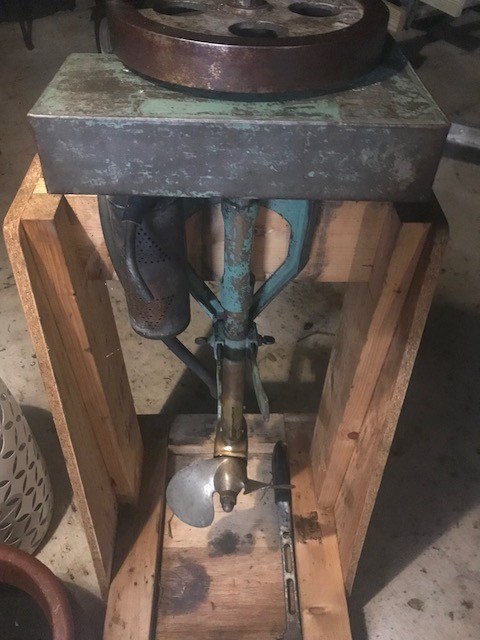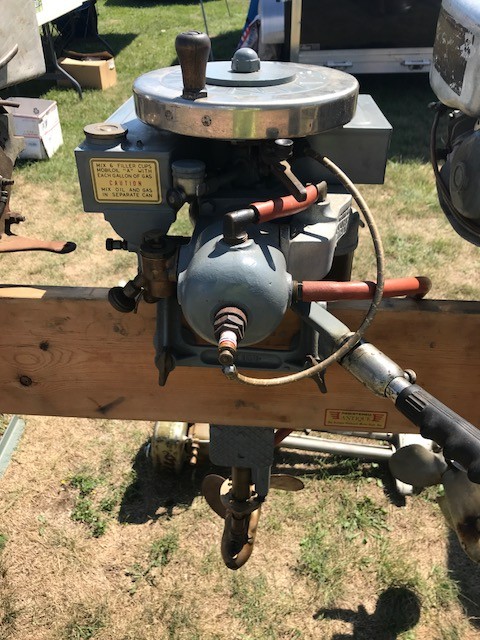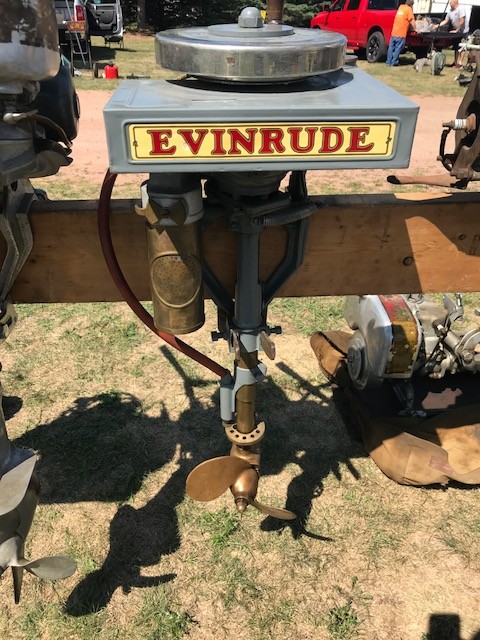- Joined
- May 15, 2010
- Messages
- 3,667
- Reaction score
- 325
- Location
- Central Florida
- LOCATION
- Lake County, Central Florida
I had made a comment in another post about vintage and antique engines being built to last. I mentioned that I had a couple of engines that were very old and was asked to post photos.
Both of these engines are in a family of engines affectionately knows as "Knuckle Busters" due to the starting technique. On each flywheel there is a raised knob. This knob is grabbed, the engine is brought up to the base of compressing and then the knob/flywheel is quickly pulled through compression. If everything is right the engines starts and off you go. If not you may end up with a very sore knuckle!
The 1913 Evinrude RBM (Row Boat Motor) pictured below is now 105 years old. I am only the third owner of the engine. The man I purchased it from this Summer bought it from the original owner and that was in 1969! One might think these engines are rare, they are not, actually they are fairly plentiful.
The engine is a single cylinder water cooled that has no magneto for ignition and has a poppet valve arrangement and mixing valve system acting as a carburetor. Super simple engine that produces roughly 2hp at a whopping 800RPM. Propeller is direct drive at a 1:1 ratio and has a 12" pitch propeller.
Ignition for the engine comes from what is commonly known as a "Buzz Box" which is made up of a Ford Model T buzz coil and a 6V battery. These are carried in separate boxes and are hooked up to the points and spark plug and grounded to the engine frame.
With the spark plug in the front of the engine, and this ignition system, operators frequently find out just how wicked hot that ignition system really is. What is not shown is the steering handle, which is also directly in front. The powerhead on the engine stays stationary and the handle steers the brass lower unit only so your hand and arm pass perilously close to the ignition as you steer. All I can say is you learn very quickly!
The exhaust system on this model is dry and has no cooling so the runner and the brass "muffler" get wicked hot. There is no gasket between the exhaust runner and the cylinder head.
These engines were originally produced by Ole Evinrude so that he could take his sweetheart, Bess, for ice cream in his boat without having to row, hence the term Row Boat Motor. The first engines were produced in 1909 and none are known to exist to my knowledge.
This engine runs and as a matter of fact this particular engine was running in less than one hour after purchasing it. The second owner asked if he could stick around to see it run for sentimental reasons and looked like he was both happy and a bit regretful that he sold it but his health dictated the sale.


This second engine is a 1918 Evinrude.
This has had a restoration done on it and is also a runner. This engine is unique as it was produced with forward and "Reverse". This thrust reversal was done at the steering handle. By rotating the handle while underway a locating pin was lifted in the lower unit and the unit spun around 180 degrees and locked in until you lifted the pin again with the handle. The lower unit is spring loaded as well to counter engine torque!
Ignition in this engine is accomplished with a magneto very similar to almost all outboards produced prior to electronic ignition. Under the flywheel is a huge ignition coil and a condenser. On the magneto advance arm there is a set of points.
Carburetion is similar to the 1913 with refinements.
This model has a water cooled exhaust and muffler. Nicer to operate and quieter as well.
This engine can also be run on a Buzz box if desired by simply disconnecting a primary link from the mag to the points and rotating it out of the way. The Buzz box system can then be wired up and off you go.


Both of these engines are in a family of engines affectionately knows as "Knuckle Busters" due to the starting technique. On each flywheel there is a raised knob. This knob is grabbed, the engine is brought up to the base of compressing and then the knob/flywheel is quickly pulled through compression. If everything is right the engines starts and off you go. If not you may end up with a very sore knuckle!
The 1913 Evinrude RBM (Row Boat Motor) pictured below is now 105 years old. I am only the third owner of the engine. The man I purchased it from this Summer bought it from the original owner and that was in 1969! One might think these engines are rare, they are not, actually they are fairly plentiful.
The engine is a single cylinder water cooled that has no magneto for ignition and has a poppet valve arrangement and mixing valve system acting as a carburetor. Super simple engine that produces roughly 2hp at a whopping 800RPM. Propeller is direct drive at a 1:1 ratio and has a 12" pitch propeller.
Ignition for the engine comes from what is commonly known as a "Buzz Box" which is made up of a Ford Model T buzz coil and a 6V battery. These are carried in separate boxes and are hooked up to the points and spark plug and grounded to the engine frame.
With the spark plug in the front of the engine, and this ignition system, operators frequently find out just how wicked hot that ignition system really is. What is not shown is the steering handle, which is also directly in front. The powerhead on the engine stays stationary and the handle steers the brass lower unit only so your hand and arm pass perilously close to the ignition as you steer. All I can say is you learn very quickly!
The exhaust system on this model is dry and has no cooling so the runner and the brass "muffler" get wicked hot. There is no gasket between the exhaust runner and the cylinder head.
These engines were originally produced by Ole Evinrude so that he could take his sweetheart, Bess, for ice cream in his boat without having to row, hence the term Row Boat Motor. The first engines were produced in 1909 and none are known to exist to my knowledge.
This engine runs and as a matter of fact this particular engine was running in less than one hour after purchasing it. The second owner asked if he could stick around to see it run for sentimental reasons and looked like he was both happy and a bit regretful that he sold it but his health dictated the sale.


This second engine is a 1918 Evinrude.
This has had a restoration done on it and is also a runner. This engine is unique as it was produced with forward and "Reverse". This thrust reversal was done at the steering handle. By rotating the handle while underway a locating pin was lifted in the lower unit and the unit spun around 180 degrees and locked in until you lifted the pin again with the handle. The lower unit is spring loaded as well to counter engine torque!
Ignition in this engine is accomplished with a magneto very similar to almost all outboards produced prior to electronic ignition. Under the flywheel is a huge ignition coil and a condenser. On the magneto advance arm there is a set of points.
Carburetion is similar to the 1913 with refinements.
This model has a water cooled exhaust and muffler. Nicer to operate and quieter as well.
This engine can also be run on a Buzz box if desired by simply disconnecting a primary link from the mag to the points and rotating it out of the way. The Buzz box system can then be wired up and off you go.




